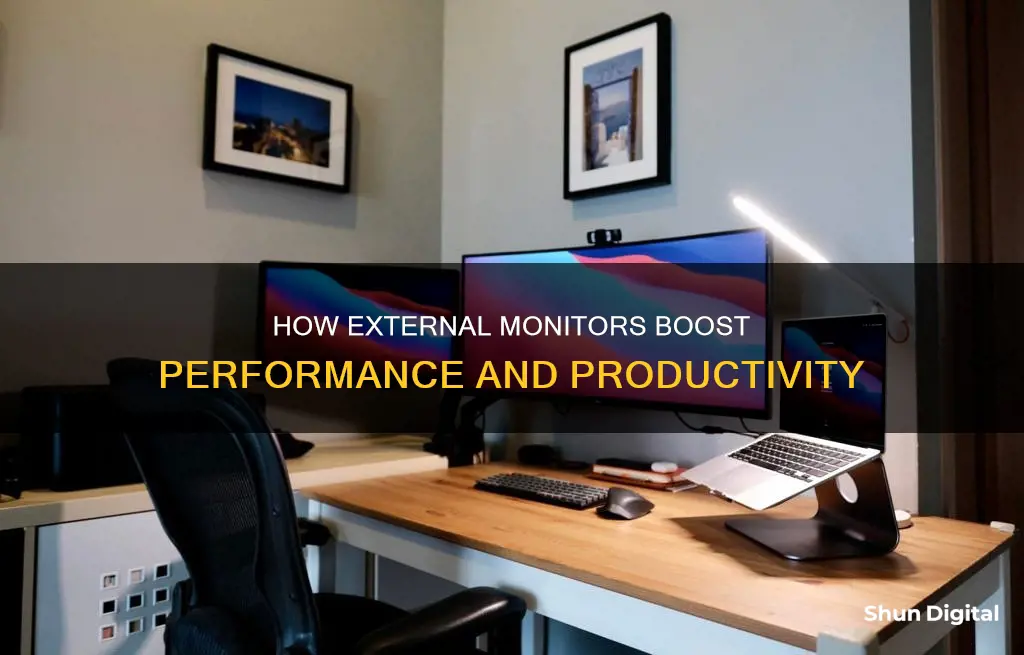
Using an external monitor with a laptop can improve gaming performance in most cases, but this is not always true. The performance boost depends on the laptop's specifications and the type of applications being used. For example, laptops with Optimus and a direct connection to the GPU via HDMI/USB-C/Display Port can experience a boost in FPS. However, if the external monitor has a lower resolution or refresh rate than the laptop, it may decrease performance or FPS. In general, using an external monitor does not reduce performance and can improve productivity, especially for users who want to multitask.
| Characteristics | Values |
|---|---|
| Effect on performance | Depends on the resolution, the applications running, and the graphics processor on the laptop |
| Effect on FPS | Depends on the game and settings; connecting an external monitor will not affect FPS unless the external monitor has a lower refresh rate than the laptop |
| Effect of using HDMI cable | Will not affect performance as long as the resolution selected is compatible with your computer and the video card supports the resolution of the external monitor |
| Effect of using VGA cable | Will not reduce performance |
| Effect of using multiple monitors | Performance decreases when screens of different resolutions are connected |
| Effect on GPU | Using an external monitor puts the GPU under more strain |
| Effect on CPU | Using an external monitor puts the CPU under more strain |
| Effect on battery life | Using an external monitor affects battery life as the processors are put under more strain |
| Effect of using multiple screens | Using multiple screens can cause the computer to stutter and slow down during action-packed sequences as it has to allocate processing power to both screens |
What You'll Learn

Does an external monitor improve gaming performance?
Using an external monitor can improve gaming performance, but this is not always the case. Many factors can affect gaming performance, such as the type of graphics processor (GPU) in your laptop, the resolution of the external monitor, and the refresh rate of the monitor.
Most modern laptops use a technology called Optimus, which allows for dynamic switching between the Discrete Graphics Processor (DGP) and the Integrated Graphics Processor (IGP). Optimus helps provide a balance between performance and power efficiency, allowing the device to use the most appropriate processor for the task. However, in an Optimus system, the output is sent via low-powered integrated graphics, even when using a discrete GPU. This can create a bottleneck that reduces performance. In such cases, connecting an external monitor can improve gaming performance.
On the other hand, if your laptop doesn't have Optimus, or if you can disable Optimus, you may not see any improvement in gaming performance by connecting an external monitor. This is because you're already bypassing the potential bottleneck caused by Optimus. Additionally, if your laptop has G-Sync or AMD Vega integrated GPU, a direct connection between the screen and the discrete GPU is required for optimal performance, and an external monitor may not provide any benefits.
The resolution and refresh rate of the external monitor can also impact gaming performance. A higher resolution or refresh rate will require more computational power and can affect the frame rate (FPS) achieved. However, having different resolutions or refresh rates on multiple monitors can also cause issues, such as stuttering or reduced performance. It is recommended to ensure that the monitors' refresh rates are clean integer multiples of each other to prevent these issues.
In conclusion, while an external monitor can often improve gaming performance, the specific configuration of your laptop and the specifications of the external monitor will determine the actual impact on performance.
RDX's Blind Spot Monitoring: A Comprehensive Overview
You may want to see also

Does a laptop's performance decrease with an external monitor?
Adding an external monitor to your laptop setup shouldn't decrease its performance unless the laptop is already running at its maximum capacity. In fact, using an external monitor can even improve the performance of your laptop in most cases.
However, the performance of your laptop with an external monitor depends on various factors, including the laptop's hardware capabilities (CPU, GPU, RAM), the resolution and refresh rate of the external monitor, and the complexity of the tasks being performed. For example, running graphically demanding games or video editing software on multiple external monitors may lead to reduced performance, as the laptop's resources are shared among the additional displays and the demanding application.
If your laptop has Optimus, which means that the integrated graphics within the processor are used to send signals to the laptop screen, you can get a performance increase by connecting an external monitor. This is because Optimus allows for dynamic switching between the Discrete Graphics Processor (DGP) and the Integrated Graphics Processor (IGP), providing a balance between performance and power efficiency. However, in an Optimus-based system, the output is sent via low-powered integrated graphics using a discrete GPU, which can create a bottleneck and reduce performance.
The resolution of the external monitor also plays a role in the laptop's performance. A monitor with the same or lower resolution than your laptop will not affect performance. However, if the external monitor has a higher resolution, it may try to default to that resolution, which could slow down performance.
To summarise, using an external monitor with your laptop generally does not decrease its performance and can even provide a boost in certain cases. However, for graphically intensive tasks or when using multiple monitors, there may be a decrease in performance due to the increased demand on the laptop's resources.
Ankle Monitors: Effective Surveillance or Easy to Cheat?
You may want to see also

How does screen resolution affect performance?
The screen resolution of a monitor can have a significant impact on its performance, particularly when it comes to gaming. Higher resolutions require more processing power from the graphics card (GPU), which can result in lower frame rates (FPS) and reduced performance. For instance, a game running at a resolution of 3840 x 2160 with V-Sync on may achieve an FPS of around 120, while the same game at a lower resolution of 1080p may achieve over 200 FPS.
The impact of screen resolution on performance is influenced by several factors, including the specifications of the GPU, the amount of RAM, and the refresh rate of the monitor. If a GPU is unable to process the large number of pixels required for a high-resolution display, the FPS will drop, leading to a decrease in performance. This is particularly noticeable when playing graphically demanding games or using applications that require high-resolution graphics.
To improve performance when using a high-resolution monitor, it is important to ensure that the system has a powerful GPU capable of handling the increased workload. Additionally, having sufficient RAM can help reduce the strain on the GPU and improve overall performance. It is also worth considering the refresh rate of the monitor, as a higher refresh rate can provide smoother visuals and improve the overall gaming experience, even if the FPS is lower.
In some cases, connecting an external monitor to a laptop can increase gaming performance. This is because some laptops utilize Optimus technology, which relies on integrated graphics within the processor to send signals to the laptop screen, resulting in reduced power consumption and longer battery life. However, when a more powerful discrete GPU is used for gaming, the output is sent through the lower-powered integrated graphics, creating a bottleneck that affects performance. By connecting an external monitor directly to the discrete GPU via HDMI or DisplayPort, the bottleneck can be bypassed, resulting in improved gaming performance.
It is worth noting that not all laptops experience a performance boost when using an external monitor. Laptops with Optimus technology that cannot be disabled, or those with outputs wired to integrated graphics, may not see any improvement. Additionally, if the laptop's screen remains active while an external monitor is connected, the integrated graphics will still be in use, potentially resulting in lower FPS. To mitigate this, users can disable the primary screen through Windows settings or close the lid of the laptop if it is not required for cooling purposes.
Locating Your CPE Monitoring Number: A Quick Guide
You may want to see also

How does an external monitor affect the laptop's GPU?
The impact of an external monitor on a laptop's GPU performance depends on several factors, including the laptop's specific hardware configuration and the type of connection used. Here's an in-depth look at how an external monitor can affect a laptop's GPU:
Many modern laptops are equipped with Nvidia Optimus technology, which allows the system to switch between integrated and discrete graphics depending on the demand. The integrated graphics are typically used for everyday tasks to conserve battery power, while the discrete graphics (GPU) are utilised for more intensive tasks like gaming. When an external monitor is connected to a laptop with Optimus, the GPU performance can be influenced in different ways.
If the external display outputs are wired directly to the discrete GPU, connecting an external monitor can boost gaming performance. This is because the discrete GPU can now render graphics exclusively for the external monitor without having to share resources with the integrated graphics. As a result, games may run smoother and achieve higher frame rates.
However, if the external display outputs are wired to the integrated graphics (typically lower-powered), there may not be a significant improvement in GPU performance. In some cases, using an external monitor while the laptop's screen is still active can even result in lower frame rates due to the additional load on the integrated graphics. To maximise GPU performance in this scenario, it is recommended to disable the laptop's primary screen through the Windows settings or by closing the lid.
Additionally, the type of connection used between the laptop and the external monitor can also play a role in GPU performance. Connections such as HDMI, USB-C, and DisplayPort often provide a direct link to the discrete GPU, allowing for improved performance. On the other hand, if the connection is routed through the integrated graphics, there may not be a noticeable difference in GPU performance.
It's worth noting that not all laptops exhibit the same behaviour when it comes to external monitors and GPU performance. Some laptops may have the option to disable Optimus, which can affect how the graphics are processed. Moreover, certain laptops with technologies like G-Sync or VR-Ready require a direct connection between the screen and the discrete GPU to function properly.
In summary, the presence of an external monitor can influence a laptop's GPU performance, but the specific impact depends on the laptop's hardware configuration and connection type. To ensure optimal GPU performance when using an external monitor, it is advisable to consult the laptop's specifications, disable the integrated graphics if possible, and utilise connections that provide a direct link to the discrete GPU.
Ankle Monitors and Alcohol: What's the Connection?
You may want to see also

Can an external monitor improve productivity?
Using an external monitor with a laptop can improve productivity, especially if you are limited by the laptop's small screen size. However, the effect of connecting an external monitor depends on several factors, including the resolution, the applications being used, and the laptop's graphics processor.
In terms of resolution, using a monitor with the same or lower resolution as your laptop will not affect performance. However, if the external monitor has a higher resolution than your laptop, it may lower performance, as your laptop will struggle to keep up with the higher-resolution display.
The type of applications being used also matters. If you are using graphics-intensive applications or playing video games, the laptop's graphics card may become a bottleneck, impacting performance. On the other hand, if you are using the laptop for business purposes or non-intensive tasks, you are unlikely to experience performance issues when connecting an external monitor.
Additionally, the laptop's graphics processor plays a role in the performance when using an external monitor. Laptops with powerful graphics processors will generally respond better to external monitors than those with weaker graphics processors.
It is also important to consider the connection method when using an external monitor. Connecting via an HDMI or DisplayPort cable will typically not affect performance as long as the resolution is compatible with your laptop. However, if the external monitor has a lower refresh rate than your laptop, it may result in a lower frame rate.
In summary, using an external monitor with a laptop can improve productivity, especially for tasks that require a larger screen area or multiple pages to be viewed simultaneously. However, it is essential to consider the factors mentioned above to ensure that the external monitor setup optimizes performance rather than hinders it.
Touchscreen Monitors: Buying Guide for Beginners
You may want to see also
Frequently asked questions
Connecting an external monitor to a laptop can increase gaming performance, but this is not always the case. The performance depends on the laptop's specifications, the type of applications being used, and the external monitor's resolution. If your laptop has Optimus, you can get a performance boost by connecting an external monitor.
If the external monitor has a lower resolution than the laptop, it will lower performance. If the external monitor has a higher resolution, there will be no noticeable difference in performance.
Yes, connecting an external monitor can affect the laptop's battery life as the processors are put under more strain.
Yes, you can connect multiple external monitors to your laptop. However, using multiple monitors may reduce performance and require more RAM.







